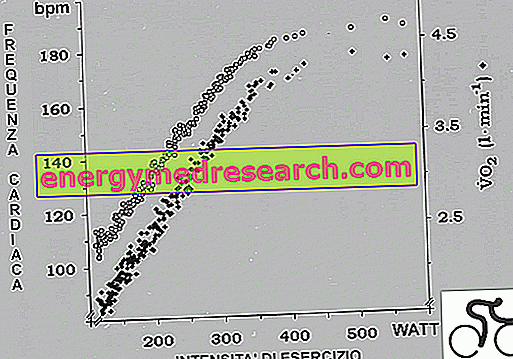Generality
Cardiac enzymes are some proteins found in the muscle fibers of the heart .

The measurement of cardiac enzymes is therefore useful as a support in diagnosing myocardial infarction and acute coronary syndrome, two diseases associated with an insufficient supply of blood to the heart. Their evaluation can also be used to determine the risk of developing one of these diseases or to monitor patients in whom such conditions are suspected.
What are
Cardiac enzymes are proteins contained in heart cells. Under normal conditions, these molecules are present in small concentrations in the blood. However, when the heart muscle is suffering following a significant ischemic event, large quantities are released into the blood stream.
What are enzymes?
Enzymes are biological catalysts that regulate and speed up metabolic reactions, thus maintaining cellular homeostasis.
Cardiac enzymes are of clinical interest as markers of myocardial injury, as they reflect the presence of necrosis (without indicating, however, the responsible mechanism).
Because they measure themselves
The evaluation of cardiac enzymes can be used:
- as a support in the quantification of myocardial damage resulting from prolonged ischemia ;
- to assess the risk that the patient has of developing a specific pathology (eg coronary syndrome, heart failure, etc.).
In particular, altered values of these markers confirm the diagnosis in the case of acute myocardial infarction in progress : when the muscle fibers suffer damage due to reduction of blood supply to the coronary arteries, cardiac enzymes are released into the blood in high quantities.
In addition to being an indicator of acute myocardial infarction, an increase in cardiac enzymes can also be seen in cases of intense strain, trauma and muscular dystrophy.
The most commonly tested myocardial enzymes in testing laboratories include:
- Creatine phosphokinase (CK or CPK), in particular the isoform released by the heart muscle (CK-MB);
- Lactate dehydrogenase (LDH);
- Myoglobin;
- Troponin I;
- Aspartate aminotransferase (AST or GOT).
Myocardial infarction
Acute myocardial infarction reflects a loss of cardiac myocytes (necrosis) caused by prolonged ischemia.
The necrosis of large areas of myocardium determines a significant increase in serum levels of cardiac enzymes. In addition to these parameters, ischemia can be identified early by history and electrocardiogram (ECG).
Diagnostic utility enzymes for myocardial infarction are divided into:
- EARLY INDICATORS (<6 hours)
- Creatine kinase (CK) : enzyme found mainly in skeletal muscle tissue and in cardiac fibers.
The measurement of the amount of creatine kinase (CK) present in the blood allows the detection and monitoring of inflammation (myositis) or serious muscle damage, including cardiac damage.
In the presence of muscle pain, increased amounts of CK are released into the blood within a few hours. If further damage occurs, CK concentrations can remain high. This makes the CK test useful for monitoring progressive cardiac damage.
Creatine kinase-MB (CK-MB) is a particular form of the enzyme, found mainly in the heart muscle. Levels of this marker increase when damage (such as acute myocardial infarction), trauma or heart surgery occurs.
The concentration of CK-MB can be measured in the follow-up, after finding an increase in total CKs, and / or when the troponin test is not available.
- Troponins : are proteins found in skeletal and cardiac muscle. These regulate muscle contraction, controlling the calcium-mediated interaction of actin and myosin.
The specific isoforms of the heart (TnI and TnT) are considered highly specific markers for the myocardium and represent one of the most important diagnostic references for evaluating the health status of the heart; in clinical practice, dosages of these enzymes are used to understand if the patient has had a heart attack or other inflammatory or ischemic problems.
However, small increases in troponins can also occur in patients with heart failure, myocarditis or pulmonary embolism.
- Myoglobin : together with troponin, this protein represents one of the most used markers to confirm or exclude any damage to the heart.
Myoglobin levels begin to increase within 2-4 hours of heart attack, reaching high levels in the next 8-12 hours; generally, the values return to normal the day after the pathological event. As a result, the exam is used to help rule out a heart attack in the emergency room.
High levels of myoglobin must be compared with the results of other tests, such as creatine kinase (CK-MB) or troponin; this makes it possible to establish whether the damage is actually on the heart or involves another skeletal muscle.
- LATE INDICATORS (> 6 hours)
- Lactate dehydrogenase (LDH) : enzyme found in most cells of the body. Its main task is to metabolize glucose to make it energy usable.
Lactate dehydrogenase is found in numerous tissues, but is concentrated mainly in the heart, skeletal muscles, liver, kidneys, pancreas and lungs. When the cells are damaged or destroyed, the LDH enzyme is released into the liquid fraction of the blood (serum or plasma), as well as increasing its concentration in other biological liquids (eg liquor) in the presence of certain diseases.
Therefore, LDH is a general indicator of tissue and cellular damage.
- Aspartate aminotransferase (AST, GOT or SGOT) : enzyme that is found in cells of the body, but is prevalent in the myocardium and in the liver, and in lower concentration, in kidneys and muscles.
In healthy subjects, blood AST values are low. When the heart, liver or muscles are damaged, this transaminase is released into the blood.
The enzyme AST does not provide additional diagnostic information compared to those already obtained with the determination of CK and LDH.
Note
It should be remembered that these parameters could also increase in other diseases such as muscle diseases, cerebral strokes and liver diseases.
Normal values
- Creatine kinase : 60 - 190 U / L ( CK-MB : 0 and 25 IU / L);
- Myoglobin : 0 - 85 ng / mL.
- Troponin I <0.1 mcg / L;
- Lactate dehydrogenase : 80 - 300 mU / mL;
- Aspartate aminotransferase : up to 45 U / L (male); up to 30 U / L (female).
Cardiac enzymes High - Causes
Troponin
Cardiac troponins are heart-specific enzymatic isoforms and normally the levels circulating in the blood are very low.
When damage occurs to heart muscle cells (myocardial necrosis), concentrations of TnI and TnT (cardio-specific troponins) may increase rapidly within 3-6 hours and may remain high for 10-14 days.
During acute myocardial infarction, troponin I has a higher specificity than isoform T (the former can be dosed 10 minutes after the pathological event, while the latter can be found in the serum after about two hours).
Possible causes of increased cardiac troponins also include angina pectoris and myocarditis (cardiac inflammation).
Creatine kinase
The presence of a high value of creatine kinase can be due to heterogeneous causes, including fatigue (eg physical exertion, intense sports training, etc.), muscle diseases (such as dystrophy) or myocardial infarction.
The causes that cause these enzymes to increase include trauma, thyroid dysfunction, alcohol abuse and infectious diseases.
CK-MB
In cases of myocardial infarction, the increase in the CK-MB isoenzyme is early; it begins to increase in the first 4-6 hours, reaches its peak rapidly (12-18 hours) and, more rapidly than the total CK, returns to normal limits.
The return to normal values generally occurs within 48 hours and therefore precedes the total CPK's time by 24 hours.
Myoglobin
When myoglobin increases, it means that there has been recent damage to the heart or other muscle tissue. The increase in this marker indicates an ongoing cardiac distress and may be related to a myocardial infarction.
High levels of myoglobin must be compared with the results of other tests, such as creatine kinase (CK-MB) or troponin; this makes it possible to establish whether the damage is actually on the heart or involves another skeletal muscle.
An increase in myoglobin values can also be found in cases of trauma, surgery or myopathies, such as muscular dystrophy.
Lactate dehydrogenase
The increase in LDH can occur in all pathological conditions characterized by the development of irreversible cellular damage (necrosis), with loss of the cytoplasmic content.
During an acute myocardial infarction, the increase in serum LDH concentration increases after 8-24 hours from the onset of the event, with a peak after 3-6 days and a return to normal values within 8-14 days.
Lactate dehydrogenase is therefore an indicator of previous infarction.
Aspartate aminotransferase
In myocardial infarction, serum aspartate aminotransferase levels increase after 8-12 hours from the onset of painful symptoms, peak at 24-48 hours and fall within the norm after 3-4 days.
Elevated AST values in the blood can also be observed following trauma and muscle diseases .
How to measure them
Myocardial enzymes are measured on a blood sample taken from a vein in the arm.
Sometimes, to determine the value of these indicators, a sample of liquid is collected from a particular area of the body (for example, around the heart) with a specific procedure.
Preparation
In general, blood sampling for cardiac enzyme analysis should preferably be performed after an 8 to 10-hour fast.
Some medications interfere with the result, therefore, it is always advisable to inform your doctor if you are following any therapies.
Interpretation of Results
The increase in the concentration of cardiac enzymes in the blood or in other biological liquids helps to determine the presence of a myocardial damage consequent to prolonged tissue ischemia, in addition to establishing the entity.
In any case, it should be remembered that the results of each examination should not be interpreted alone, but always in the light of the results of other analyzes, which may be indicated by the doctor, from time to time.



